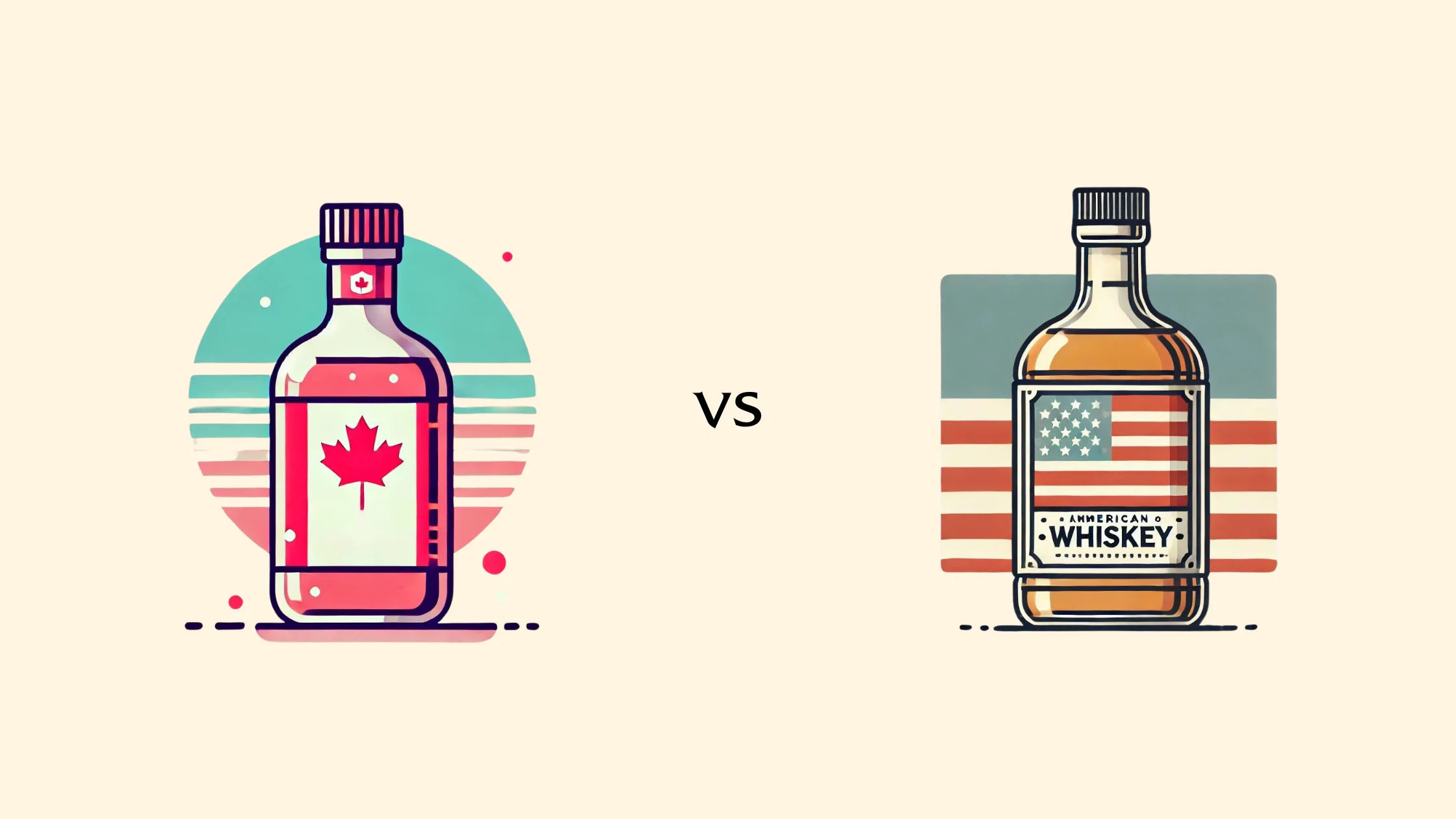When it comes to Canadian Whisky vs. American Whiskey, each brings something unique to the table. Canadian Whisky is known for its smooth and mellow flavor, thanks to a careful blending process. It’s versatile and perfect for cocktails or sipping straight. On the flip side, American Whiskey, like Bourbon and Tennessee Whiskey, is all about bold, rich flavors with strict production rules that give it a distinctive taste. Whether you’re into the easy-drinking Canadian style or the robust American kick, both types offer delicious ways to enjoy whisky from North America.
The Defining Characteristics of Canadian Whisky
Canadian Whisky is celebrated for its smoothness and subtlety, often resulting from a meticulous blending process. Typically lighter and smoother than its international counterparts, this spirit primarily uses corn, but rye, barley, and wheat can also play significant roles in its composition. The flexibility in its mash bill allows for a wide range of flavor profiles, making Canadian Whisky exceptionally versatile.
Notable Canadian Whisky brands that exemplify these defining characteristics include Crown Royal, known for its deluxe blend that has received international acclaim, and Lot No. 40, celebrated for its rye-forward profile that showcases the versatility of Canadian rye whisky. Canadian Club is another iconic brand, offering a range of whiskies that highlight the smooth and approachable nature of Canadian Whisky.
These brands, among others, contribute to the global recognition of Canadian Whisky, with several products receiving awards at international spirits competitions, further reinforcing Canada’s reputation for producing high-quality whisky. Aging in wooden barrels for a minimum of three years imparts a gentle complexity, further defining its distinct character. Additionally, the practice of blending different grain whiskies after they have been individually aged is a hallmark of Canadian Whisky, contributing to its harmonious and balanced flavor.
This approach to whisky production showcases the craftsmanship and innovation inherent in Canadian distilleries, setting their products apart on the global stage.
The Defining Characteristics of American Whiskey
American Whiskey stands out for its bold flavors and strict production standards. The spirit’s identity is deeply rooted in its variety, with Bourbon and Tennessee Whiskey being prominent examples, each adhering to specific regulations regarding their production and aging processes. Bourbon, for instance, must contain at least 51% corn in its mash bill and be aged in new, charred oak barrels, contributing to its rich and full-bodied flavor profile.
Iconic brands like Jack Daniel’s and Jim Beam have become synonymous with American Whiskey, showcasing the depth and diversity of flavors that define this category. Tennessee Whiskey, while similar to Bourbon, goes through an additional step known as the Lincoln County Process, where the spirit is filtered through charcoal before aging, imparting a distinctive smoothness. This process is exemplified by Jack Daniel’s, which has significantly impacted the global whiskey market with its unique smoothness and rich flavor.
Rye Whiskey, another significant category, offers spicy and complex notes, requiring a mash bill of at least 51% rye. Brands like Rittenhouse and Bulleit Rye highlight the spicy, bold character that rye brings to the American whiskey landscape. This diversity, coupled with the rise of craft distilleries exploring innovative distillation and aging techniques, underscores the dynamic and evolving nature of American Whiskey.
Craft distilleries like Buffalo Trace and Maker’s Mark have introduced innovative expressions that push the boundaries of traditional American Whiskey, further enriching its variety and appeal.
In What Ways Are They Similar?
Despite the distinct paths Canadian Whisky and American Whiskey have taken, they share several fundamental similarities that unite them under the broad whiskey umbrella. Both spirits are deeply rooted in rich histories and traditions that have shaped their development over centuries. They adhere to specific aging processes, requiring time in barrels to develop their complex flavors, although the exact time and type of barrels may differ.
Additionally, both Canadian Whisky and American Whiskey showcase a diversity of grains in their mash bills, allowing for a wide range of flavor profiles within each category. This versatility makes both types of whiskey highly adaptable to various cocktail recipes and consumption preferences. For example, the classic Manhattan and Old Fashioned cocktails can be crafted with either Canadian Whisky or American Whiskey, demonstrating their influence on cocktail culture.
Moreover, the commitment to craftsmanship and innovation is evident in both Canadian and American distilleries, with producers continuously exploring new techniques and expressions to delight whiskey enthusiasts worldwide. Shared challenges such as navigating global markets and adhering to evolving regulations highlight their resilience and adaptability in the face of industry shifts.
In What Ways Are They Different?
Canadian Whisky and American Whiskey diverge significantly in their production regulations, flavor profiles, and historical contexts. One of the most striking differences lies in their production standards. Canadian Whisky, for example, allows for a more flexible approach to the grains used in the mash bill, often resulting in a smoother, lighter spirit.
This flexibility is exemplified by brands like Crown Royal, which offers a range of whiskies from smooth blends to more robust, rye-forward expressions, showcasing the variety within Canadian Whisky itself. In contrast, American Whiskey categories like Bourbon and Rye have strict regulations regarding grain composition, aging processes, and even barrel types, leading to bolder, more distinctive flavors. For instance, Buffalo Trace Bourbon, with its deep amber color and complex flavors, adheres to the requirement of containing at least 51% corn and aging in new, charred oak barrels, which imparts a rich, full-bodied profile distinct from Canadian offerings.
Similarly, Rye Whiskey in the U.S., such as Rittenhouse Rye, must contain at least 51% rye, offering spicy and complex notes that stand in contrast to the often smoother Canadian rye whiskies. Furthermore, Canadian Whisky’s aging process in used or new barrels contrasts with the American mandate for new, charred oak barrels, impacting the final taste. Historically, these spirits have been shaped by different cultural influences and legal frameworks, contributing to their unique identities.
While Canadian Whisky has evolved under the influence of British and French heritage, American Whiskey has been distinctly shaped by American history and innovation, reflecting the diverse character of the United States. These differences not only highlight the rich diversity within the whiskey world but also the specific traditions and approaches that define each spirit’s unique charm.
Comparing Canadian Whisky and American Whiskey
Comparing Their Flavor
| Canadian Whisky Examples | Flavor Profile | American Whiskey Examples | Flavor Profile |
|---|---|---|---|
| Crown Royal Deluxe | Smooth, light, and subtly sweet | Buffalo Trace Bourbon | Bold, rich, with a hint of sweetness |
| Lot No. 40 | Spicy rye, smooth | Rittenhouse Rye | Spicy and complex |
Comparing Their Price Range
| Whisky Type | Budget-Friendly | Premium |
|---|---|---|
| Canadian Whisky | Canadian Club (Around $20) | Glen Breton Rare 10-Year (Around $80+) |
| American Whiskey | Evan Williams Bourbon (Around $15) | Pappy Van Winkle’s 15-Year Bourbon (Around $1200+) |
Comparing Their Distillation Process
| Whisky Type | Grain Approach | Aging Process |
|---|---|---|
| Canadian Whisky | Flexible grain use, may include rye, corn, barley | Aged in either new or used barrels, minimum 3 years |
| American Whiskey | Strict mash bill requirements, e.g., Bourbon must be at least 51% corn | Bourbon aged in new, charred oak barrels |
Comparing Their Popularity
| Region | Canadian Whisky | American Whiskey |
|---|---|---|
| North America | Highly popular in Canada | Extremely popular in the USA, growing in Canada |
| Europe | Growing presence | Strong demand, especially for Bourbon |
Comparing Their Critical Acclaim
| Award | Canadian Whisky Winner | American Whiskey Winner |
|---|---|---|
| World Whiskies Awards 2022 | Alberta Premium Cask Strength Rye | George T. Stagg |
| San Francisco World Spirits Competition | Caribou Crossing Single Barrel | Eagle Rare 17 Year Old Bourbon |
Who Is Canadian Whisky Best For?
Canadian Whisky is the ideal choice for those who appreciate a smooth, versatile spirit that can be enjoyed in a variety of ways. Its light and often subtly sweet profile makes it perfect for both newcomers to the whisky world and seasoned enthusiasts looking for a refined experience. The flexibility in flavor profiles, from the gentle and approachable to the rich and complex, ensures that Canadian Whisky has something to offer for every palate.
Additionally, its adaptability in cocktails, from classic to contemporary creations, makes it a favored ingredient among mixologists. Whether sipped neat, on the rocks, or as part of a mixed beverage, Canadian Whisky caters to a broad audience, embodying a spirit of inclusivity and accessibility. Profiles of Typical Canadian Whisky Enthusiasts:
- Newcomers to Whisky: Individuals exploring the whisky world for the first time find Canadian Whisky’s smoothness less intimidating and more approachable.
- Cocktail Aficionados: Mixologists and cocktail lovers appreciate Canadian Whisky for its versatility in a wide range of drinks, from a classic Manhattan to innovative new concoctions.
- Seasoned Whisky Drinkers: Those with a refined palate for whisky enjoy the subtle complexities and nuanced flavors that Canadian Whisky offers, especially when sipped neat or on the rocks.
Favored Occasions and Settings:
- Casual Gatherings: Its smooth and approachable nature makes Canadian Whisky a popular choice for casual social gatherings, where it can be enjoyed neat or in mixed drinks.
- Cocktail Parties: Canadian Whisky shines in cocktail parties, where its versatility allows for a broad menu of cocktail options.
- Quiet Evenings at Home: The gentle and soothing profile of Canadian Whisky makes it a favored companion for a relaxed evening at home, either as a solo indulgence or as part of a meal pairing.
Canadian Whisky’s broad appeal, from its smoothness to its mixability, makes it a staple for a diverse range of whisky enthusiasts and occasions, embodying a spirit of inclusivity and accessibility that few other whiskies can claim.
Who Is American Whiskey Best For?
American Whiskey is ideally suited for those who savor bold flavors and rich histories embedded within their spirits. Enthusiasts who relish the complexity and depth that come from strict production standards and innovative distillation techniques will find American Whiskey, particularly Bourbon and Rye, deeply satisfying. Its robust profile appeals to connoisseurs seeking a spirit with a strong character that stands up well both neat and in more complex cocktails.
The craft whiskey movement has attracted a new generation of drinkers, drawn to the artisanal qualities and regional variations of American Whiskey. This spirit appeals to a diverse range of palates, from those who enjoy the spicy kick of a good rye to those who prefer the smooth, sweet notes of corn-based whiskies. Whether for a seasoned whiskey aficionado or a curious newcomer intrigued by American heritage, American Whiskey offers a rich and engaging experience.
Trends in Consumer Behavior: Recent trends show a growing interest among millennials and Gen Z consumers, who are drawn to the stories behind craft brands and the authenticity they represent. American Whiskey fits seamlessly into lifestyles that value artisanal, locally sourced, and handcrafted products. Social media platforms have also played a significant role in shaping perceptions, with influencers and enthusiasts sharing their American Whiskey experiences, from distillery tours to cocktail recipes, further broadening its appeal.
Lifestyle and Consumption Patterns: American Whiskey is increasingly becoming a symbol of sophistication and a choice for special occasions, not just among seasoned drinkers but also among those new to the whiskey scene. It’s found its place in upscale bars and restaurants, home bars, and as a preferred gift among spirits enthusiasts. The versatility of American Whiskey, from sipping it neat to enjoying it in a crafted cocktail, aligns with a wide array of consumption occasions and preferences, making it a staple for both casual gatherings and formal celebrations.





